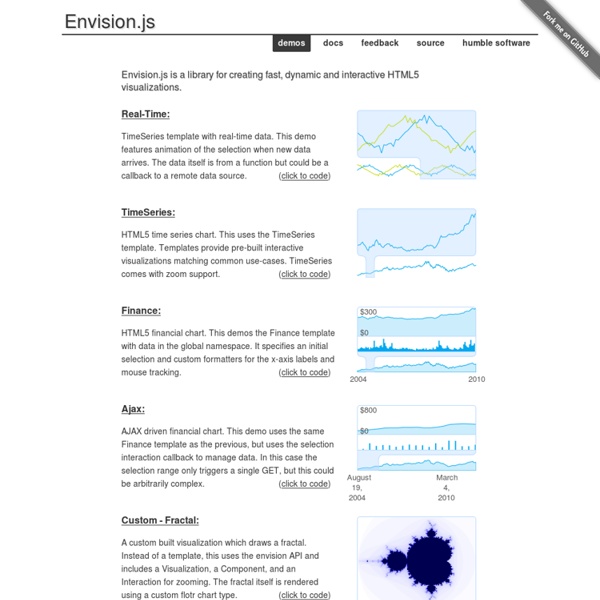



Datavisualization.ch Selected Tools Dance.js Cubism.js Time Series Visualization foo7.6 bar−6.2 foo + bar1.4 foo - bar14 Cubism.js is a D3 plugin for visualizing time series. Scalable Cubism fetches time series data incrementally: after the initial display, Cubism reduces server load by polling only the most recent values. Effective Cubism also scales in terms of perception: small multiples aligned by time facilitate rapid comparison. Area (120px)7.6 Area (30px)7.6 In contrast, horizon charts reduce vertical space without losing resolution. Horizon, 1-band (120px)7.6 Horizon, 2-band (60px)7.6 Horizon, 3-band (40px)7.6 Horizon, 4-band (30px)7.6 By combining position and color, horizon charts improve perception: position is highly effective at discriminating small changes, while color differentiates large changes. Flexible Cubism is data-source agnostic. Want to learn more?
Cube Time Series Data Collection & Analysis Cube is a system for collecting timestamped events and deriving metrics. By collecting events rather than metrics, Cube lets you compute aggregate statistics post hoc. It also enables richer analysis, such as quantiles and histograms of arbitrary event sets. Cube is built on MongoDB and available under the Apache License on GitHub. Collecting Data An event in Cube is simply a JSON object with a type, time, and arbitrary data. Cube’s collector receives events and saves them to MongoDB. Querying Events Cube defines a simple language for querying events. You can intersect filters and customize which event fields are returned. request(browser).gt(duration, 250).lt(duration, 500) Cube supports both HTTP GET and WebSockets for retrieving events. Querying Metrics You can also use Cube to group events by time, map to derived values, and reduce to aggregate metrics. The first few results of which appear as: sum(request.eq(path, "/search")) sum(request(duration))
Backbone.js Backbone.js gives structure to web applications by providing models with key-value binding and custom events, collections with a rich API of enumerable functions, views with declarative event handling, and connects it all to your existing API over a RESTful JSON interface. The project is hosted on GitHub, and the annotated source code is available, as well as an online test suite, an example application, a list of tutorials and a long list of real-world projects that use Backbone. Backbone is available for use under the MIT software license. You can report bugs and discuss features on the GitHub issues page, on Freenode IRC in the #documentcloud channel, post questions to the Google Group, add pages to the wiki or send tweets to @documentcloud. Backbone is an open-source component of DocumentCloud. Downloads & Dependencies (Right-click, and use "Save As") Backbone's only hard dependency is Underscore.js ( >= 1.5.0). Introduction Many of the examples that follow are runnable. Upgrading to 1.1
arbor.js gka/chroma.js Gephi, an open source graph visualization and manipulation software laverdet/node-fibers Raphaël—JavaScript Library SVG Graphics Library for JavaScript HTML5 :jsDraw2DX